
The History of the Tea Bag: From Accidental Invention to Global Staple
These days, it’s hard to imagine a world without the convenience of the tea bag. Whether at home, in an office, or in a hotel room, the tea bag is the epitome of comfort, satisfaction and simplicity.
This unassuming little pouch has a fascinating history—one that encompasses accidents, innovation, and changing global habits.
Life before the bag
Before tea bags came into use, tea was brewed exclusively using loose leaves. This method, still preferred by many connoisseurs, involves steeping leaves in hot water, often in a teapot with a strainer or using an infuser. Loose leaves were the norm for centuries in Asia, the Middle East, and Europe.
However, while the flavour delivered by loose leaf tea can be superior, the brewing process is less than convenient, especially for those seeking a quick and tidy cuppa during a busy day.
An accidental invention
Many of the world’s finest innovations have been inspired by accidental discoveries and this was the case with the tea bag.
In 1908, Thomas Sullivan, a tea importer from New York, began sending small silk pouches of tea as samples to his customers. Rather than opening the bags, some of the recipients simply dunked the whole pouch into hot water—and found that it worked rather well.
Sullivan soon realised that there was significant potential in his little bags and refined the design. He switched from using luxurious silk to inexpensive gauze. The cheaper material reduced production costs and improved extraction.
The first modern tea bag had been born.
Design evolution
As demand grew, the tea bag evolved. In the 1920s, tea bags became commercially available in the United States and were often sewn by hand. It wasn’t until the 1930s that paper fibre bags were developed. These were easier and much cheaper to produce. The heat-sealed tea bag was introduced in 1944 and eliminated the need for stitching.
Strings and tags were added to the bags during the 1950s, making tea bags easier to handle without burning any fingers.

A slow boil
Interestingly, while tea bags quickly caught on in the U.S., they took much longer to gain popularity in Britain where loose leaf tea culture was somewhat entrenched.
Tetley became the first major brand to introduce tea bags to the UK market in 1953. The bags were initially viewed with scepticism as many people felt they were inferior products or indicative of laziness.
But by the 1980s, more than half of British households were using tea bags.
Today, over 95% of tea consumed in the UK is brewed from tea bags
Modern innovations
As tea bags became the standard, manufacturers introduced further changes. Pyramid-shaped bags were launched in the 1990s to allow more room for leaves to expand, improving flavour – allegedly!
In response to environmental and health concerns (microplastic contamination), many brands now offer plastic-free, compostable bags.
Tea bags have expanded beyond black tea to include green tea, rooibos, fruit infusions, and more.
The debate continues
Despite their convenience, tea bags are not without their critics. Many tea lovers argue that loose leaf tea provides better flavour, as it typically features higher-quality leaves, while bagged tea may rely on lower-grade tea and dust. Bagged tea can also lead to the ingestion of microplastics and phthalates.
Phthalates are known to be endocrine-disrupting chemicals, meaning they can interfere with the body's hormone system, potentially causing a variety of health issues.
Improved sourcing and better bag designs (like the pyramid bag) have helped close the quality gap in recent decades but there are signs that loose leaf tea is making a comeback.
The story continues
From a shipping fluke in a New York office to a cupboard essential across the globe, the tea bag’s journey is one of innovation and adaptation. The bags have transformed how we consume the world’s most popular beverage—making tea more accessible, more portable, and more present in daily life than ever before.



Leave a comment